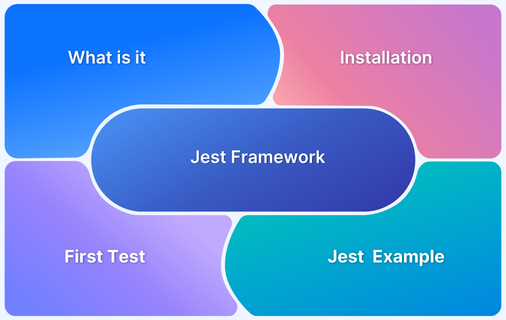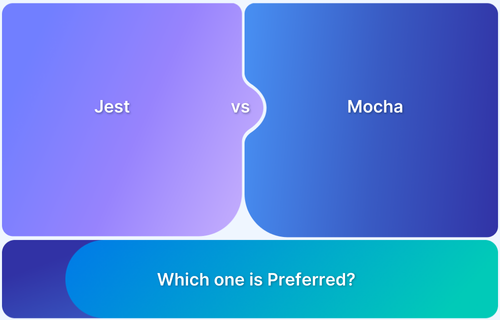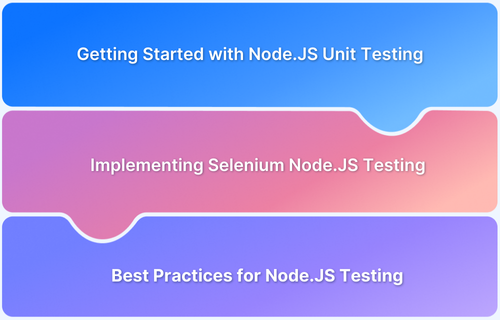When it comes to JavaScript testing, choosing the right framework is crucial for efficient development and test automation. Jest, Mocha, and Jasmine are three popular testing frameworks, each offering unique features and strengths.
Overview
Jest
A JavaScript testing framework developed by Facebook, offering a zero-config setup, built-in test runner, and features like snapshot testing, mocking, and parallel test execution.
Mocha
A flexible JavaScript testing framework that works with various assertion libraries and mock tools, providing a customizable environment for unit and integration testing.
Jasmine
A behavior-driven development (BDD) testing framework for JavaScript that provides built-in assertions, spies, and mocks, designed for writing clean and readable tests.
Jest vs Mocha vs Jasmine
- Configuration and Setup: Jest requires no configuration, ideal for quick setups. Mocha needs an external test runner and assertion library. Jasmine offers minimal setup with built-in assertions and test runner.
- Test Runner: Jest has a built-in test runner with parallel execution. Mocha needs an external test runner (e.g., Karma). Jasmine includes its own test runner but lacks advanced features.
- Mocking and Spying: Jest provides built-in mocking and spying (jest.fn, jest.spyOn). Mocha requires external tools like Sinon. Jasmine supports spies but lacks advanced mocking.
- Asynchronous Testing: Jest natively supports async testing with promises/async/await. Mocha uses done() or async/await for async tests. Jasmine also supports async testing with promises/async/await.
- Features: Jest offers snapshot testing, code coverage, and watch mode. Mocha is lightweight, flexible, and customizable. Jasmine focuses on BDD with built-in assertions and spies.
- Popularity and Use Cases: Jest is popular in React and modern JS apps. Mocha is used in Node.js projects for flexibility. Jasmine is favored in Angular projects and BDD testing.
This article explores a detailed comparison of Jest vs Mocha vs Jasmine to help you choose the proper JavaScript Testing framework for your project.
Jest vs Jasmine vs Mocha: A Quick Comparison
Here’s a quick comparison of Jest, Mocha, and Jasmine based on their features and suitability for different types of testing projects:
| Aspect | Jest | Jasmine | Mocha |
|---|---|---|---|
| Purpose | Zero-config testing framework | Flexible testing framework | BDD testing framework |
| Test Runner | Built-in | External (e.g., Karma) | Built-in |
| Assertions | Built-in (expect) | Requires external (e.g., Chai) | Built-in |
| Mocking/Spying | Built-in (jest.fn, jest.spyOn) | External (e.g., Sinon) | Built-in spies |
| Configuration | Zero-config | Requires setup | Zero-config |
| Async Testing | Native async support | Uses done() or async/await | Native async support |
| Test Execution | Parallel execution | Sequential execution | Sequential execution |
| Use Cases | React and modern JS apps | Node.js and backend applications | Angular and BDD projects |
What are JavaScript Testing Frameworks?
JavaScript testing frameworks are tools designed to automate the process of testing JavaScript code, ensuring that applications run smoothly and as expected.
These frameworks provide the structure and utilities needed to write, organize, and execute tests efficiently. They support a variety of testing methodologies, such as unit testing, integration testing, and functional testing, helping developers identify bugs, improve code quality, and maintain stability during development.
JavaScript testing frameworks typically include features like assertions (to check expected values), test runners (to execute tests), and mocking capabilities (to simulate components or services).
Popular frameworks like Jest, Mocha, and Jasmine simplify the testing process, making it easier to write automated tests, run them repeatedly, and integrate them into continuous integration/continuous deployment (CI/CD) pipelines.
To further optimize your testing efforts and ensure cross-browser compatibility, BrowserStack Automate allows you to run your JavaScript tests across a wide range of real browsers and devices on a cloud-based platform. This helps ensure that your web applications work seamlessly across different environments, providing a faster and more efficient testing process.
How to choose a proper Javascript Testing Framework?
Choosing the proper Javascript testing framework based on your project and business needs is crucial for accurate output.
It is prudent to consider the following aspects when you choose a testing framework:
- Accuracy: Each testing framework is different. They have similarities with their counterparts and some uniqueness of their own. You can choose the proper framework by focusing on which feature of the framework benefits your project the most.
- Scalability: Applications that are developed never go stagnant. They are constantly updated and upgraded, and new features are introduced. So you can select the framework that can handle more extensive and complex codebases.
- Integration: Choose the proper testing framework to make integrating with other software and technologies hassle-free.
- Maintenance: A well-designed framework can help make writing tests easier and maintain them effectively. It saves much time and helps with future updates and upgrades.
- Coverage: The proper testing framework will help you achieve better test coverage, so you can test more aspects of your code and catch more bugs.
- Productivity: An ideal testing framework will quickly run tests and give feedback. It should also help capture bugs earlier in the development process.
What is Jest?
Jest is one of the most popular JavaScript Testing frameworks used to test applications. It was primarily developed to test React-based apps. However, it can test any application designed with most JavaScript code bases.
Facebook developed it, and the primary aim of the Jest Testing framework was to keep the test environment user-friendly. If the application is UI intensive, Jest is the go-to framework. It was built on top of the Jasmine Testing Framework. However, Jest has many additional layers and added features.
The following are some of the unique features of the Jest Testing Framework:
- Provides built-in/auto-mocking capabilities, which make it easy to create mock functions and objects for testing. This can help simplify the testing process and make it easier to test complex applications.
- Has a feature called snapshot testing, which allows you to capture a snapshot of the application output and compare it to a previous image. This can help identify unexpected changes in the application output.
- Has built-in code coverage reporting, which allows developers to analyze how much of their code is covered by tests. This can help identify areas of the application that need more testing and improve overall code quality.
- Allows you to run tests in parallel, which can help reduce testing time and speed up the development process.
- It can be easily integrated with other devices and libraries, such as Babel and Webpack, which makes it a popular choice for testing modern JavaScript applications.
However, there are some areas where the Jest Testing Framework needs to catch up.
- It allows minimal customization, and tailoring the framework to specific testing needs isn’t easy.
- Owing to its large size, the initial setup time and memory usage can impact the application’s performance. This can be a problem for projects with many functionalities to test or a large codebase.
- Jest has many features and configurations. The learning curve for using Jest can be steeper than other testing frameworks, especially for beginners.
- Jest may not be compatible with all versions of JavaScript, which can be a problem for projects that need to support older versions of the language.
Read More: Understanding Testing Library Jest DOM
What is Mocha?
Mocha was developed to test applications running on Node.js. It provides a flexible and extensible testing environment. It is well suited for complex testing needs.
Here are some of the key features of Mocha:
- Supports various JavaScript Assertion libraries like Chai, Should.js, Express.js, etc.
- It has multiple ways of generating test summary reports. You may choose whichever suits your project best.
- Supports both Asynchronous and Synchronous Testing.
- Mocha is easy to set up and use, even for developers new to testing. It has a simple and intuitive syntax for writing test cases and comes with a command-line interface that makes it easy to run tests and view results.
- Mocha has a large and active community of developers who contribute to the project and provide support to other users.
- Mocha has a wide range of plugins and integrations, allowing you to customize the framework to our needs.
- Testing an application with a complex backend is easy with Mocha.
While Mocha has many benefits, there are some potential downsides to using this framework:
- Mocha has no built-in assertion library; You must choose and configure one according to your needs. E.g., Chai.
- Auto-mocking and snapshot testing are complicated.
- Mocha performs slower than other software testing frameworks when executing large test suites.
Follow-Up Read: Choosing between Jest and Mocha
What is Jasmine?
Jasmine is an older framework than Jest and Mocha. Jasmine Testing Framework is an open-source framework that comes as a single package.
Some of the key Jasmine framework features are listed below.
- Jasmine Testing Framework primarily supports Behaviour Driven Development (BDD)
- You need not import external libraries while running Jasmine.
- It is compatible with most frameworks and libraries making it versatile and the go-to framework if your primary concern is integration with other tools and libraries.
- Has many built-in assertions that simplify the coding process and help make the code readable.
- Test Scriptwriting is very simple and easy with Jasmine. So, testers who are beginners can benefit from Jasmine.
- It does not depend on DOM, browsers, or any JavaScript framework.
- For complete end-to-end testing of UI and backend, Jasmine is highly recommended.
- Community support for Jasmine is tremendous but less compared to Mocha.
As with any framework, Jasmine comes with its load of cons too:
- Debugging can be a bit harder than other testing frameworks as it does not provide much information, and the source of the error is difficult to find.
- Jasmine has difficulty with asynchronous testing.
- Though it supports Snapshot testing and has its library, the integration is not easy.
Read More: Best Automation Testing Tools
Jest vs Mocha vs Jasmine: Which to choose?
Here’s a comparison of Jest, Mocha, and Jasmine based on their use cases to help you determine which framework is the best fit for your project:
| Jest | Mocha | Jasmine |
|---|---|---|
| Jest was primarily developed for React and worked well with Next.js too. | Mocha is better suited for applications designed with Node.js | Jasmine works better with Angular.js. |
| For powerful UI-based applications, Jest is a good choice. | For complex back-end applications, Mocha is a proper fit. | Jasmine works better with light and simple projects. |
| Built-in assertion libraries and auto-mocking features are available. | No built-in assertion libraries are available. You can use external assertions like Chai. | Built-in assertions are available. |
| The auto-mocking feature is part of the Jest package | Test doubles are not built-in. Simon.js can be used for mocking. | Test doubles are part of the Jasmine framework. |
| Jest package has a test runner built within its framework. | Test runners are available. | Test runners are not available by default. We have to install additional test runners like Karma. |
| Asynchronous testing is easy and fetches good results. | Asynchronous testing performance is not as excellent as Jest | Asynchronous testing performance is not as outstanding as Jest |
| Supports only Test Driven Development (TDD) | Supports Behavior Driven Development(BDD) and Test Driven Development (TDD) | Primarily supports Behavior Driven Development(BDD) |
Altogether, each testing framework has its Pros and Cons
- If you want to compare Jest Vs Mocha Vs Jasmine based on speed, Jest is the winner.
- Among the three, Mocha is more flexible, but additional libraries must be installed for certain main features.
- Mocha Vs Jasmine will lead you to choose Mocha for testing heavy and complex back-end applications and Jasmine for lightweight applications.
- For UI testing, when it comes to Jest vs Jasmine, Jest is preferred by many.
- Jasmine, the oldest among the three JavaScript testing, does not have an advanced test reporting feature.
All three being popular JavaScript Testing frameworks, the competition between Jest Vs Mocha Vs Jasmine will continue to prevail. You should evaluate your project requirements and choose a framework best suited for your project and team.
- You can run your JavaScript Unit Tests on BrowserStack for end-to-end application testing.
- For fast high-grade Selenium Testing that is compatible across 3500+ real mobile devices and desktop browsers, use BrowserStack Automate.
Conclusion
The choice between Jest, Mocha, and Jasmine depends largely on your project’s specific needs. Jest is an excellent choice for modern JavaScript projects and React applications, offering a zero-config setup with powerful features.
Mocha is best suited for Node.js applications, providing flexibility and a customizable setup. Jasmine, with its behavior-driven development approach, is perfect for Angular projects and teams that prefer a simpler, built-in test runner with spies and mocks.
To further enhance your testing process, BrowserStack Automate offers several powerful features. It enables parallel test execution for faster results and seamless integration with popular CI/CD tools. It also provides real device testing for accurate, real-world results, helping ensure your applications are cross-browser compatible and perform optimally across all platforms.
FAQs
1. Are Jest and Jasmine the same?
Jest and Jasmine are both testing frameworks for JavaScript, but they are not the same. Here are some differences between the two:
- Jest is a more modern and comprehensive testing framework than Jasmine. Jest includes features like snapshot testing, code coverage analysis, and parallel test execution, which are unavailable in Jasmine.
- Jest is developed and maintained by Facebook, while Jasmine is an open-source project maintained by a community of developers.
- Jest has built-in support for mocking and assertions, while Jasmine requires you to use external libraries for these features.
- Jest has a faster test runner than Jasmine, which can make a difference for large test suites.
2. Which is better Jest or Jasmine?
While both Jest and Jasmine are capable testing frameworks, Jest may be a better choice for more complex testing scenarios due to its richer feature set and faster execution speed.
3. Is Jest better than Mocha?
Whether Jest is better than Mocha depends on the specific needs of your project. Both are popular and capable testing frameworks that can do the job effectively.
- Jest is an all-in-one testing framework with features like mocking, assertion, and code coverage analysis.
- While Mocha is a more lightweight framework that focuses on providing a flexible test runner and letting you choose your assertion library and mocking library.
- Mocha provides more flexibility in configuration and integration with other tools, making it a better choice for projects with complex testing requirements.
- Mocha has been around longer than Jest, which means it has a more established user base and a larger collection of plugins and extensions.







